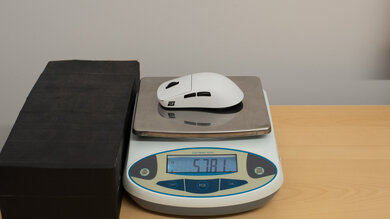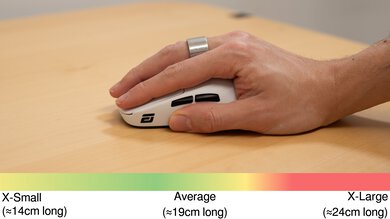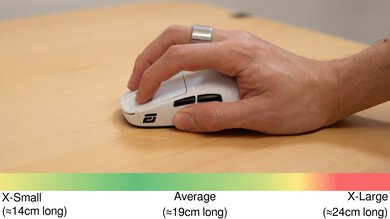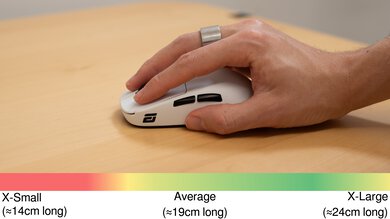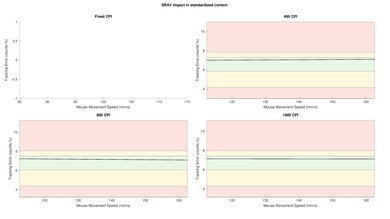The Endgame Gear OP1we is a lightweight wireless gaming mouse. It has a symmetrical shape and a low hump positioned towards the back of the mouse that's identical to the other mice in Endgame Gear's OP1 lineup. Endgame Gear positions this mouse and other "wireless essentials" (we) models in the upper mid-range category since it uses the PixArt 3370 sensor, which is the best of the previous generation of sensors. It also uses Kailh GO optical switches, which you can easily hot-swap for an alternate set of Kailh optical switches.
Our Verdict
The Endgame Gear OP1we is decent for work despite not being specifically designed for it. It has excellent build quality with a comfortable symmetrical shape, and you can remap its buttons using the companion software. It connects wirelessly with its USB receiver but doesn't support Bluetooth or multi-device pairing. Also, its scroll wheel has no additional functionality like free scrolling or L/R tilt inputs.
-
Excellent build quality.
-
Small shape is unsuitable for large hand sizes.
-
No Bluetooth connectivity or multi-device pairing.
-
Scroll wheel lacks free-scrolling and L/R tilt inputs.
The Endgame Gear OP1we is an excellent mouse for FPS gaming. It's very lightweight, making it easy to move quickly and accurately, and its small, symmetrical shape is ideal for claw or fingertip grip types. It also delivers remarkable raw performance with excellent click latency and sensor latency, providing a responsive gaming experience.
-
Excellent click latency.
-
Amazing sensor latency.
-
Very lightweight.
-
Excellent build quality.
-
Small shape is unsuitable for large hand sizes.
-
1000Hz polling rate is no longer cutting edge.
The Endgame Gear OP1we is a good mouse for MMO gaming, but it doesn't have nearly as many side buttons as a dedicated MMO mouse. That said, you can still program almost all of its buttons using the companion software, and it has excellent build quality and raw sensor performance.
-
Excellent click latency.
-
Amazing sensor latency.
-
Excellent build quality.
-
Small shape is unsuitable for large hand sizes.
-
1000Hz polling rate is no longer cutting edge.
-
Significantly fewer side buttons compared to dedicated MMO mice.
The Endgame Gear OP1we has remarkable raw performance. Despite using the older PixArt 3370 sensor, it delivers excellent click and sensor latency, providing an accurate and consistent gaming experience. That said, its maximum polling rate is 1000Hz, which doesn't detract from the experience but falls short of some of the competition offering higher polling rates.
-
Excellent click latency.
-
Amazing sensor latency.
-
1000Hz polling rate is no longer cutting edge.
- 7.2 Work
- 8.8 Video Games (FPS)
- 7.7 Video Games (MMO)
- 9.1 Raw Performance
- Updated May 07, 2024: We've added a link to the newly-reviewed Endgame Gear OP1 8k in the Click Latency section of this review.
- Updated May 02, 2024: Review published.
- Updated Apr 18, 2024: Early access published.
- Updated Apr 17, 2024: Our testers have started testing this product.
- Updated Apr 16, 2024: The product has arrived in our lab, and our testers will start evaluating it soon.
- Updated Apr 16, 2024: We've purchased the product and are waiting for it to arrive in our lab.
Differences Between Sizes And Variants
The Endgame Gear OP1we is available in black or white. We bought and tested it in white. You can see the label of our unit here.
Compared To Other Mice
The Endgame Gear OP1we is a lightweight wireless gaming mouse with a symmetrical shape. It shares its shape with other mice in Endgame Gear's OP1 lineup, like the OP1, the OP1 8K, and the OP1 RGB. It's on the smaller side and is designed for fingertip and claw grip types. It's only really suitable for a palm grip if you have small hands. It uses the PixArt PAW3370 sensor, which, while excellent-performing, only supports a maximum polling rate of 1000Hz, whereas the newer PixArt PAW3395 sensor found in mice like the LAMZU Atlantis Mini 4K, Pulsar X2V2, and Endgame Gear OP1 8k supports higher polling rates. This mouse also offers the unique advantage of having easily hot-swappable optical switches. Endgame Gear even sells lighter replacement switches on its website here. Overall, this mouse is a fantastic choice if you're looking for a high-performance gaming mouse that stands out for its smaller shape and excellent build quality.
For more options, see our recommendations for the best gaming mouse, the best wireless gaming mouse, and the best claw grip mouse.
The Endgame Gear OP1 8k and the Endgame Gear OP1we are gaming mice that share the same shape and belong to the same wider product lineup. The OP1 8k is a wired-only model that's more geared towards enthusiasts. It offers significantly better click latency and sensor latency. It's also lighter and has a higher maximum polling rate of 8000Hz. It also uses mechanical SPDT switches. The OP1we, on the other hand, is a wireless model. It still offers superb raw performance but doesn't quite match that of the OP1we. It uses optical switches and has a lower maximum polling rate of 1000Hz.
The Endgame Gear OP1we and the Endgame Gear XM2we are lightweight wireless gaming mice. They have symmetrical shapes with similarly excellent build quality and grippy matte finish. While their overall shapes are similar, the XM2we is significantly larger than the OP1we, making it a better fit if you have large hands. Performance-wise, the two mice are similar. They have the same PixArt 3370 sensor, but the XM2we's raw performance is better.
The Endgame Gear OP1we and the Logitech G PRO X SUPERLIGHT 2 are lightweight wireless gaming mice with symmetrical shapes. The Endgame Gear is smaller and has a hump that's closer to the back of the mouse, making it well-suited for fingertip and claw grip types. The Logitech has a well-rounded shape that's suitable for a wide range of hand sizes and grip types. Both mice deliver excellent performance, but the Logitech has better click latency and a maximum polling rate of 8000Hz, whereas the endgame gear has a maximum polling rate of only 1000Hz.
The Endgame Gear OP1we and the Endgame Gear XM1r are symmetrical high-performance gaming mice. The OP1we offers wireless connectivity, whereas the XM1r is wired-only. Their shapes are slightly different, too, with the OP1we being smaller and much narrower than the XM1r. Both mice have excellent build quality, but the XM1r is available in a variety of different colors and coatings, whereas the OP1we is only available in black or white with a matte coating. Both mice deliver excellent performance, but the XM1r has lower latency and a more accurate sensor.
The Endgame Gear OP1we and the Razer Viper V2 Pro are lightweight wireless gaming mice with symmetrical shapes. The Endgame Gear is smaller and more explicitly designed for claw grip types, whereas the Razer has a safer shape that's suitable for various grip types and hand sizes. The Razer performs better thanks to its lower click latency and more accurate sensor. It also supports higher polling rates if you buy Razer's HyperPolling dongle, which is sold separately.
Test Results
This mouse has a simple design similar to that of other Endgame Gear models, like the Endgame Gear XM2we. It has a matte plastic finish and is available in black or white. On the left side of the mouse, there is an LED battery life/CPI indicator just below the Endgame Gear logo, but it's hardly visible.
This mouse has excellent build quality. Its solid plastic body has a chalky-feeling "dry grip" coating that feels very high-quality. It's well put together, doesn't creak or rattle during normal use, and doesn't even flex if you press into the body forcefully.
This mouse is designed to be easily opened to change the main click buttons thanks to the exposed screws on the underside of the mouse.
This mouse has a narrow, symmetrical shape with a low hump towards the back of the body. It has flat sides that widen slightly at the back of the mouse. Its shape accommodates most grip types if you have smaller hands, but it's best suited for claw and fingertip grip types. If you have larger hands, you'll likely find it too small for a palm or relaxed claw grip.
You can connect to this mouse wirelessly with its included 2.4 GHz USB receiver. Endgame Gear advertises a maximum battery life of 7 days at its maximum polling rate of 1000Hz.
This mouse has a lightweight, flexible, paracord-like charging cable that glides smoothly across desks and mousepads. However, it retains some minor permanent kinks from its packaging. The cable terminates in a USB-C connector that plugs into the mouse and is angled slightly upwards to minimize drag.
This mouse's feet glide smoothly across mousepads but are slightly scratchy-sounding when used directly on a desk, but this doesn't affect gliding performance. The mouse includes an additional skate that fits around the sensor. Endgame Gear sells replacement feet on its website here, and third-party replacement feet are also available.
This mouse's main button switches are hot-swappable with other Kailh GO optical switches. Endgame Gear sells a set of lighter switches on their website here.
You can reprogram all buttons on this mouse using its companion software, including the CPI button on its underside. However, left-click must always be assigned, and you can't reprogram the scroll up or down inputs.
This mouse has excellent click latency performance. It delivers a highly responsive experience that's suitable for casual or competitive gaming.
We tested this mouse at its maximum polling rate of 1000Hz and using its lowest debounce setting of 0ms.
If you're interested in a mouse in the same lineup that offers significantly lower click latency and you don't mind using a wired-only model instead, see our review for the Endgame Gear OP1 8k.
This mouse's sensor accurately tracks your movements with minimal variation or errors.
We tested this mouse's CPI performance at its maximum native polling rate of 1000Hz.
This mouse delivers amazing sensor latency performance. It reacts to your movements quickly and translates them accurately to the cursor movements you see on-screen.
We tested this mouse at its maximum polling rate of 1000Hz.
The available polling rate options are 125Hz, 250Hz, 500Hz, and 1000Hz. You can adjust the CPI manually using the configuration software in increments of 50 up to 10000 CPI and increments of 100 from 10000 to 19000 CPI.
This mouse has a grooved rubber scroll wheel. It operates quietly and has smooth but well-defined steps. The scroll click is satisfyingly tactile, and you can also actuate it by pressing it to the right.
The left- and right-click buttons and the scroll wheel operate somewhat quietly, but the side buttons are noticeably louder. Still, this mouse isn't likely to bother those around you.
The configuration software for this mouse is simple, lightweight, and easy to use. It allows you to adjust a range of expected settings, including button mapping, custom profiles, CPI, debounce time, polling rate, lift-off distance, ripple control, and angle snapping. The software also has a battery life indicator.






